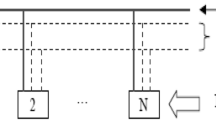Abstract
Multi-channel ad hoc networks are promising technology to alleviate the spectrum scarcity in dense networks. The main challenge for channel access in distributed multi-channel ad hoc networks is channel synchronization and competition with neither common control channel nor dedicated control transceiver. In this paper, a Tight Synchronized MAC protocol with distributed synchronization and competition process without any dedicated control channel is proposed. The protocol uses a simple handshaking mechanism to create a channel table for each node, which contains its neighbors and channels’ status. By this, any node knows the priority of its channels and also the priority of neighbors’ channels. By assigning priorities, a sender node starts synchronization. If sender and receiver nodes have a common channel, the proposed method finds it directly or indirectly using the common neighbor mechanism. The other feature of the proposed scheme is using a fair preemptive data transmission phase, which reduces the number of switchings along data transmission. The fair preemptive mechanism is achieved by an analytical solution to estimate the number of competing nodes and thus, estimates the number of assigned data slots. Simulation results show the performance improvements in terms of synchronization delay and packet delivery ratio over HMMAC and MSRMMAC protocols.














Similar content being viewed by others
References
Ali, A., Huiqiang, W., Hongwu, L., & Chen, X. (2014). A survey of MAC protocols design strategies and techniques in wireless ad hoc networks. Journal of Communications, 9(1), 30–38.
Almotairi, K. H., & Shen, X. (2013). Multichannel medium access control for ad hoc wireless networks. Wireless Communications and Mobile Computing, 13(11), 1047–1059.
Zhao, H., Zhang, M., Gao, K., Mao, T., & Zhu, H. (2019). A multi-channel cooperative demand-aware media access control scheme in vehicular ad-hoc network. Wireless Personal Communications, 104(1), 325–337.
Hadded, M., Muhlethaler, P., Laouiti, A., Zagrouba, R., & Saidane, L. A. (2015). TDMA-based MAC protocols for vehicular ad hoc networks: A survey, qualitative analysis, and open research issues. IEEE Communications Surveys and Tutorials, 17(4), 2461–2492.
Chao, C. M., Tsai, H. C., & Huang, C. Y. (2017). Load-aware channel hopping protocol design for mobile ad hoc networks. Wireless Networks, 23(1), 89–101.
Masud, F., Abdullah, A. H., Abdul-Salaam, G., & Ullah, F. (2017). Traffic adaptive MAC protocols in wireless body area networks. Wireless Communications and Mobile Computing, 2017.
Taneja, K., Taneja, H., & Kumar, R. (2018). Multi-channel medium access control protocols: Review and comparison. Journal of Information and Optimization Sciences, 39(1), 239–247.
Mo, J., So, H. S. W., & Walrand, J. (2007). Comparison of multichannel MAC protocols. IEEE Transactions on Mobile Computing, 7(1), 50–65.
Dang, D. N. M., Nguyen, V., Le, H. T., Hong, C. S., & Choe, J. (2016). An efficient multi-channel MAC protocol for wireless ad hoc networks. Ad Hoc Networks, 44, 46–57.
Song, C., Tan, G., Yu, C., Ding, N., & Zhang, F. (2017). APDM: An adaptive multi-priority distributed multichannel MAC protocol for vehicular ad hoc networks in unsaturated conditions. Computer Communications, 104, 119–133.
Nguyen, V., Oo, T. Z., Chuan, P., & Hong, C. S. (2016). An efficient time slot acquisition on the hybrid TDMA/CSMA multichannel MAC in VANETs. IEEE Communications Letters, 20(5), 970–973.
Almotairi, K. H., & Shen, X. S. (2014). A distributed multi-channel MAC protocol for ad hoc wireless networks. IEEE Transactions on Mobile Computing, 14(1), 1–13.
Cao, X., Song, Z., & Yang, B. (2018). Multi-slot reservation-based multi-channel MAC protocol for dense wireless ad-hoc networks. IET Communications, 12(10), 1263–1271.
Le, T., & Moh, S. (2018). Hybrid multi-channel MAC protocol for WBANs with inter-WBAN interference mitigation. Sensors, 18(5), 1373.
So, J., & Vaidya, N. H. (2004, May). Multi-channel mac for ad hoc networks: Handling multi-channel hidden terminals using a single transceiver. In Proceedings of the 5th ACM international symposium on mobile ad hoc networking and computing (pp. 222–233). ACM.
So, H. W., Walrand, J., & Mo, J. (2007, March). McMAC: A multi-channel MAC proposal for ad-hoc wireless networks. In Proceedings of the IEEE WCNC (pp. 334–339).
Lazowska, E. D., Zahorjan, J., Graham, S., & Sevcik, K. C. (1984). Quantitative system performance: Computer system analysis using queuing network models. Prentice-Hall.
Calvo, R. A., & Campo, J. P. (2007). Adding Multiple Interface Support in NS-2.
Author information
Authors and Affiliations
Corresponding author
Additional information
Publisher's Note
Springer Nature remains neutral with regard to jurisdictional claims in published maps and institutional affiliations.
Rights and permissions
About this article
Cite this article
Abedi, O., Pourhasani, A. Prioritized multi-channel MAC protocol in ad hoc networks using a TDMA/CSMA approach. Wireless Netw 27, 2629–2640 (2021). https://doi.org/10.1007/s11276-021-02581-7
Accepted:
Published:
Issue Date:
DOI: https://doi.org/10.1007/s11276-021-02581-7




